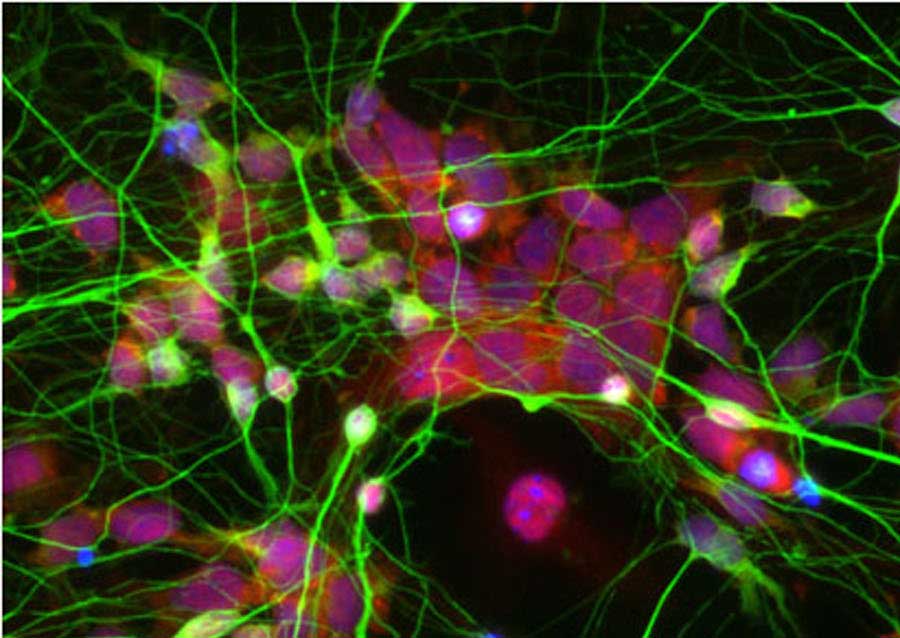An almost fearless brain Understand article
Wouldn’t it be great to live without fear? Or would it? Research is showing just how important fear can be.

the most read novels of the
20th century.
Image courtesy of Chris
Goldberg; image source: Flickr
Living a fearless life is one of the favourite topics of fiction novels and films. In the 1932 novel Brave New World, happiness is easy: just take a pill and your problems will disappear, together with any fear. For me, a neuroscientist and science-fiction lover, it is amazing to see some of Aldous Huxley’s fiction becoming reality in laboratories that investigate the neural basis of fear.
Despite its varied causes, fear results in remarkably similar symptoms: your heart races and you start to sweat. In the extreme – a panic attack – you are also suffocating, dizzy and nauseous, and you are terrified of losing control or of dying.
The selective removal of specific fears is a key goal in neuroscience, as we search for treatments for phobias, post-traumatic stress disorder and other anxiety disorders. In Europe, more than 43 million people are affected by such conditions (see table 1), and current treatments include psychotherapy and antidepressants. These are helpful approaches, but in some cases they do not work or they have unpleasant side effects. To provide more effective treatments, we need to understand how the brain processes fear.
| Condition | Number affected (millions) |
|---|---|
| Panic disorder | 5.3 |
| Agoraphobia | 4.0 |
| Social phobia | 6.7 |
| Generalised anxiety disorder | 5.9 |
| Specific phobias | 18.5 |
| Obsessive compulsive disorder | 2.7 |

connect with thousands of
other neurons, creating
millions of neuronal circuits.
Image courtesy of Penn State;
image source: Flickr
To this end, researchers are now exploring one region of the brain: the hypothalamus. Located deep within the brain, the hypothalamus is a kind of ancient brain centre for motivations and internal drives such as hunger. Although human impulses such as the desire for happiness or love are not limited to the hypothalamus, they relate to basic motivations that have their roots in the need to survive and reproduce. If the energy levels in your body run low, for example, certain neurons in the hypothalamus will scream out, triggering the sensation of hunger. Similarly, a chain of neurobiological reactions underlies the sensation of thirst when your body is short of water; anger if someone invades your territory; and fear if you encounter a fierce dog.
How does this work? We know that the hypothalamus consists of more than 15 groups of nerve cells – neurons – which all use a variety of chemical messengers and receptors to communicate with each other. We know very little, however, about which of these types of neuron are involved in each survival motivation. Nor do we yet understand how the hypothalamus co-ordinates such an array of diverse functions. Are the same neurons involved? Or do distinct but neighbouring cells rapidly communicate to determine which response to trigger?
To answer these questions, scientists need to systematically deconstruct the hypothalamus into its component parts, like thousands of pieces of a large jigsaw puzzle. This can be done by switching specific neurons on or off using nothing but a flash of light.
Does this sound like the stuff of science fiction? In fact, it is one of the techniques used in the research group that I worked in at the European Molecular Biology Laboratory (EMBL)w1. A photoactive protein, like those present in our eyes, is introduced into a specific type of neuron in the brain. The protein can then trigger or silence the activity of the neuron in response to a flash of laser light. When researchers in our group used light to switch off certain neurons in the hypothalamus of mice, the mice lost all sense of fear. Instead of avoiding a rat – a natural predator of mice – they approached it, forcing us to stop that particular experiment to protect the mice.

how dangers are avoided in
nature.
Image courtesy of nick ta;
image source: Flickr
Intriguingly, a similar behaviour has been observed in humans – which first suggested to neuroscientists that fear is controlled by different areas of the brain. Before we knew the hypothalamus was involved in fear, we thought perhaps the only area of the brain involved was another small region known as the amygdala. A woman known in the scientific literature only as ‘SM’ had a genetic condition that destroyed neurons in the amygdala, which is known as the centre of emotions and an essential component in processing fear. Over the years, scientists exposed SM to all kinds of terrible stimuli including horror movies, poisonous snakes and spiders, but she showed no fear. One day, however, they asked her to breathe in air with a high concentration of carbon dioxide. This raises the carbon dioxide levels in the blood and would normally be associated with suffocation. This, finally, caused SM to panic – she screamed for help while pulling the mask away. Scientists observing her concluded that other brain regions besides the amygdala must be able to trigger and process fear.
For the first time, SM had experienced fear. What a wonderful idea, you might think. Removing fear is what scientists are searching for, to help treat anxiety disorders and other conditions. SM’s life, however, demonstrates the importance of fear. Over the years, her lack of fear had led her into many dangerous situations – including many assaults – because she did not recognise the early signs of danger, just like the mouse that carelessly approached the rat. Fear is not only unpleasant and disturbing but is also there to warn us of dangers.
This research illustrates the importance of striking a balance, which scientists continue to investigate. Basic emotions can be vital but become harmful in the extreme. In Brave New World, for example, people paid a very high price for absolute happiness and fearlessness: they lost their freedom. Perhaps the purpose of fear is also to point out the need to constantly evaluate and react, to make appropriate choices, and to seek answers about our emotions and behaviours at home, work or school.
References
- Wittchen HU, Jacobi F (2005) Size and burden of mental disorders in Europe—a critical review and appraisal of 27 studies. European Neuropsychopharmacology 15: 357–376. doi: 10.1016/j.euroneuro.2005.04.012
Web References
- w1 – Learn more about the European Molecular Biology Laboratory (EMBL).
Resources
- The fearless mouse approaching a rat was first observed in this research:
- Silva BA et al (2013) Independent hypothalamic circuits for social and predator fear. Nature Neuroscience 16: 1731–1733. doi: 10.1038/nn.3573
- To learn more about the case of SM, see:
- Feltman R (2015) Meet the woman who can’t feel fear. Washington Post Jan 20
- Costandi M (2013) Researchers scare ‘fearless’ patients. Nature News Feb 2013
- To find an explanation of optogenetics, the technique to control neuronal activity with light, see:
- Rutherford A (2015) Cell control in a flash. EMBLetc Jan 26
- To learn how optogenetics can be used to investigate brain circuits, see:
- Gross C (2014) Fight or Flight. EMBL Insight Lecture, Feb 16
- To learn about previous EMBL research into the role of the amygdala in fear, see:
- Stanley (2011) A neural switch for fear. Science in School 18: 32–35
Institutions
Review
This interesting article introduces readers to the innovative method of optogenetics for exploring brain functions. One function is to process fear, an emotion produced by different brain regions such as the hypothalamus and the amygdala.
Fears of authority or failure are feelings that the majority of children experience in school. As the author points out, these kinds of stress should be carefully managed by teachers and students, to set the equilibrium point where valid objectives aren’t seen as ‘refutable’ or a ‘threat’. But does fear have the potential to enhance learning? Cognitive neuroscientists believe so.
Several investigations have shown that, when processing emotionally charged information, the hypothalamus and amygdala trigger a profuse secretion of the hormone adrenaline. Among the effects of the so-called ‘fight or flight’ mechanism is the improvement of cortical memory; an emotional event is always recorded with extra vivacity, for better processing and knowledge.
Recently, I observed a curious pedagogic ‘experiment’ conducted by a secondary science teacher. In one class, the students learned about anatomical features of predator dinosaurs (Tyrannosauraus rex and others) through an expository lesson supported by direct instruction, reading and watching a BBC documentary segment. In a different class the teacher made a brief introduction and then showed the Jurassic Park movie! Can the reader guess which class achieved better results in retrieving the information?
Luis M Aires, Antonio Gedeao Secondary School, Portugal





